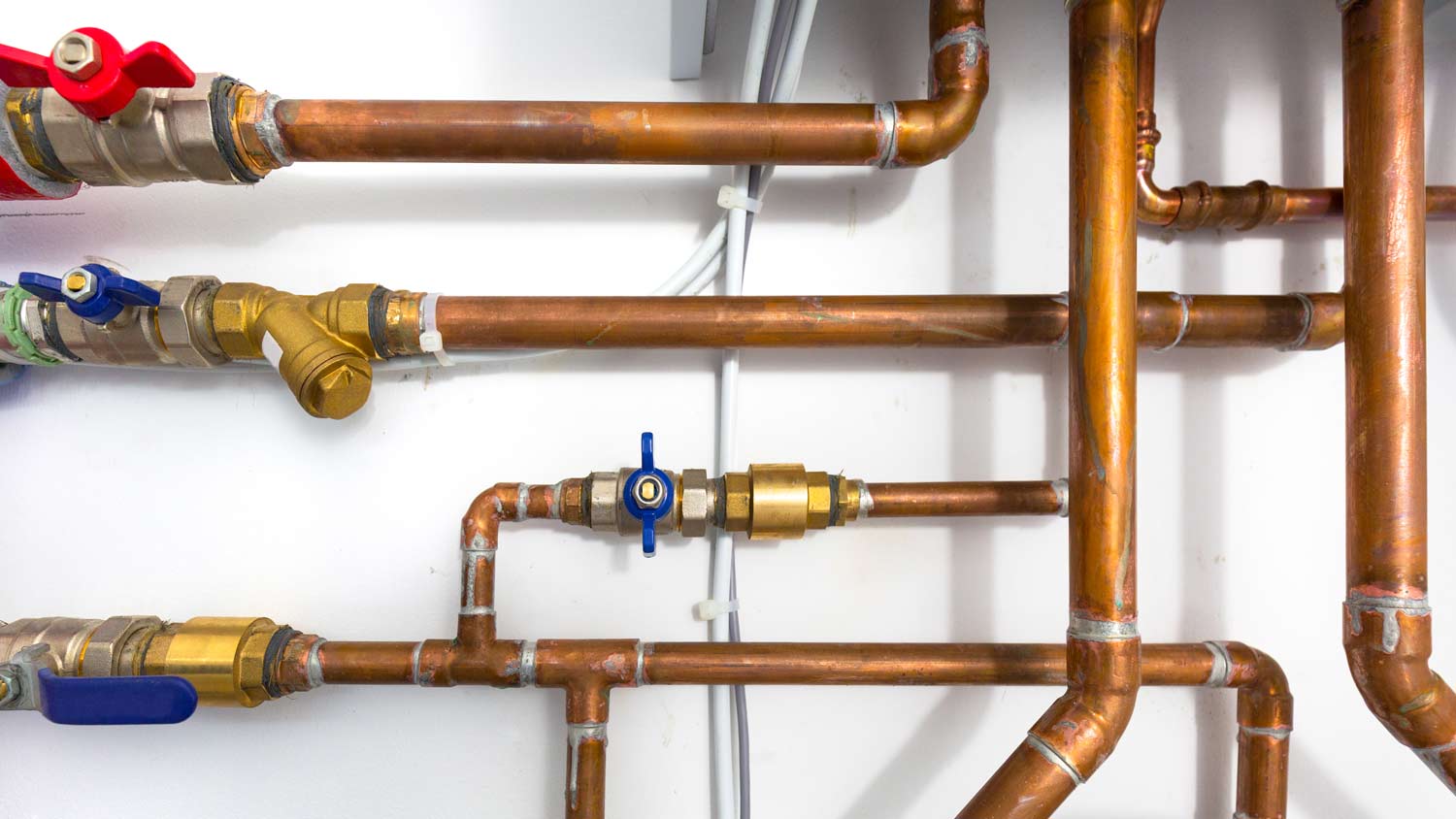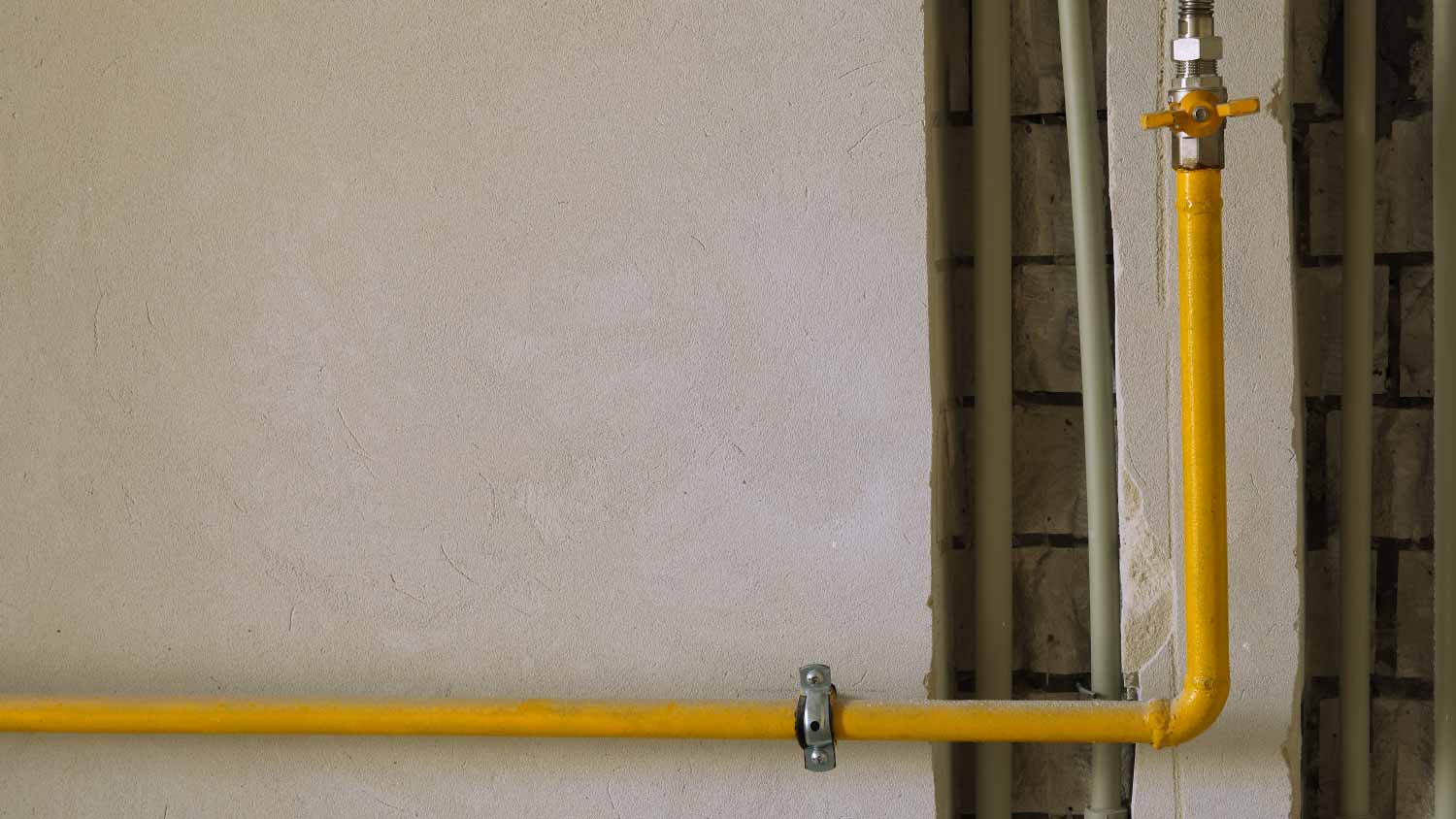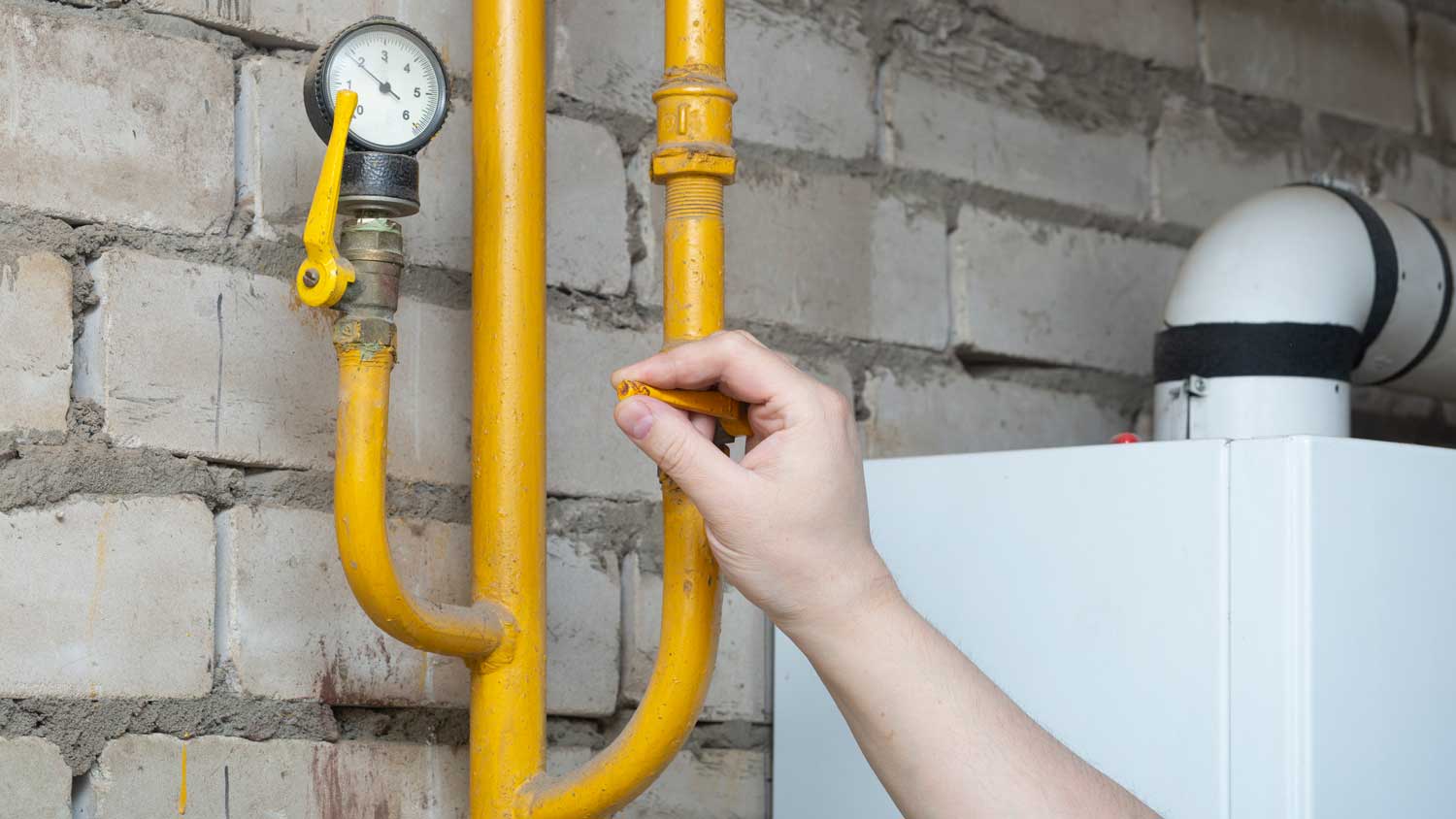How Much Do Gas Line Installation or Repairs Cost?
Running a natural gas line to your typically costs around $540, and most homeowners see totals that fall between $260 and $820.


Gas line installation costs vary with location, complexity, terrain, appliance, and pipe materials.
The cost of new gas lines for appliances is based on the length of the gas line and ease of access to the area.
If you need to trench or move the pipes during installation, plan for additional expenses for landscaping, concrete, or floor repairs.
The cost of moving a gas line can be similar to installing a new one, so consider the pros and cons of both options.
For this installation, you’ll need to hire a licensed plumber who will charge an average of $45 to $200 per hour.
Whether you're adding new gas appliances, upgrading from electric to gas, or increasing the number of gas lines at your home, you’ll want to know the costs and considerations involved in gas line installation. While prices range from $120 to $1,350, most homeowners spend between $260 and $820 on gas line installation costs. Read on for more details about what to expect when you’re budgeting for a new line.
How Much Does Underground Gas Line Installation Cost by Linear Foot?
A gas line costs $15 and $25 per linear foot, depending on the complexity of your property’s terrain and layout. Several turns will cost more because each pipe requires measuring, cutting, and threading. Digging under concrete and landscaping increases the price.
Cost to Install a Gas Line by Location
Urban gas line installation is usually more expensive because it often needs a horizontal directional drilling technique that uses bore paths instead of trenches to get under road structures.
Here's a look at what people around the country pay on average for underground gas line installation:
| Location | Average Cost |
|---|---|
| Nevada | $502 |
| North Carolina | $508 |
| Connecticut | $542 |
| Florida | $552 |
| Ohio | $599 |
| Colorado | $600 |
| Virginia | $627 |
| New York | $690 |
| Texas | $753 |
| California | $956 |
Gas Line Installation: Cost Breakdown
Gas line installation breaks down to material, labor fees, and permits.
| Project Cost | Price |
|---|---|
| Plumbing Labor | $45–$200 per hour |
| Materials | $1–$10 per foot |
| Trenching | $4–$12 per foot |
| New gas meter installation | $300–$600 |
| Permits | $100–$300 |
The complexity of the project will influence your costs. For instance, deeper trenching work will take longer and cost more labor fees.
Some code requirements call for a gas line pressure test to detect leaks via pressure drops. Standard tests cost between $75 and $150. However, some local codes call for 12-hour or 24-hour testing that can cost as much as $500.
Gas Line Installation Cost by Materials
Materials to install or repair a gas line cost $1 to $9 per linear foot. This includes connectors, fittings, piping, and mounting hardware. Costs vary depending on the type and diameter of the pipe, the number of turns in the line, and whether its location is underground, interior, or exterior. Piping types include stainless steel, PVC, polyethylene, galvanized steel, iron, and copper.
Iron, galvanized steel, and stainless steel are the most common materials.
| Material | Cost Per Linear Foot |
|---|---|
| Iron | $5–$9 |
| Stainless Steel | $2–$5 |
| Galvanize Steel | $2–$9 |
| High-density polyethylene (HDPE) | $1–$2 |
| PVC | $0.2–$2 |
| Copper | $1–$3 |
Does Using Natural Gas vs. Propane Impact Installation Costs?
The type of gas you use will not significantly impact the cost to install a gas line. However, natural gas is generally less expensive than propane. Additionally, the type of gas may affect the type of pipe material. You will also need to install new pipes when making the switch from natural gas to propane and vice versa.
If you’re currently leasing a propane tank, your lease agreement may include a hookup price of about $75. The cost to buy and install your own propane tank is $400 to $2,800.
Otherwise, you can lease a tank from your local gas company for $50 to $200 per year, or free with a minimum annual gas purchase.
Cost to Install a Gas Line by Appliance
Installation and material costs vary based on where you're connecting your gas line. The length of the pipe, access to the area, and local building codes will naturally sway the cost.
Cost to Install Gas Line for Kitchen Range or Stove

Installing a gas line for your kitchen range or stove will cost around $20 per linear foot. For example, the average length of piping needed to connect the kitchen to the main gas supply is 30 feet, so most homeowners end up spending around $600 for a true chef's experience.
Cost to Install Gas Line to Outdoor Grill and Fire Pit

The cost to run a gas line to an outdoor BBQ is between $20 and $25 per linear foot for flexible tubing to go under a deck or yard. For fire safety, outdoor fire pits should be at least 10 feet away from a home.
Dryer and Water Heater Gas Line Costs
Adding a gas line for these essential appliances usually costs $20 per linear foot. The motivation for paying the money to have an appliance like a dryer hooked into natural gas is that gas dryers are more efficient than electric dryers. You'll generally pay more up-front for the gas dryer unit than an electric dryer to access those cost savings in your monthly utility bill.
Gas Fireplace Costs
Expect to pay $15 to $25 per linear foot to make things cozy with your new gas-powered fireplace. The overall cost to convert a wood fireplace to gas averages around $3,000 but can range from $500 to $5,500.
Gas Line Costs for Furnace and Pool Heater
It's about $20 per linear foot when adding a line to a gas furnace or pool heater. In total, you'll pay between $350 and $2,100 for the cost of gas line installation of a pool heater.
Additional Factors That Impact the Cost to Run a Gas Line
Whenever you work with something as complex as power lines and pipework, there will be costs beyond basic labor and materials. Laying a new pipe will trigger other projects, such as landscaping or floorboard replacements. You will also typically need to call an inspector to ensure the work is correctly installed.
Inspection
An inspection is required and costs $50 to $75, or up to $300 in some regions. Inspect your gas system annually for rust and ensure your meter works correctly.
Landscaping Costs
Trenching to bury a gas line ranges from $300 to $10,000, depending on your landscaping. Landscapers charge about $50 to $100 per hour.
Repairs to Concrete, Drywall, or Flooring
The cost to repair a gas line ranges from $15 to $25 per linear foot. However, budget $75 to $125 per cubic yard for concrete work and $300 to $925 for the cost of drywall repairs. The cost to repair floors is $2 to $30 per square foot.
Cost to Move a Gas Line
At $15 to $25 per linear foot on average, the cost to move a gas line is comparable to the cost to install a new one. You may need to move a line if you’re rearranging your appliances during a renovation. For example, if the gas line for your stove is old or your appliances require wider pipes, you may need to replace the line with a new one.
Gas Line Leak Repair Costs
Gas leaks smell like rotten eggs due to sulfur additives included to alert you to the problem. If you notice the smell, or if you hear hissing or see a white cloud near your gas line, turn your gas off immediately and call your gas company’s emergency number. Minor leaks cost less to repair than the cost of installing a brand-new gas line, which averages $540.
Leak repair costs vary depending on the type of piping and the location of the leak:
At the junction behind a stove: $120–$250
Behind a wall or in a crawl space (repair includes drywall costs): $270–$760
In a buried line (repair includes excavation and landscaping): $1,500–$5,000
Keep in mind, the cost to hire an emergency plumber can depend on when you call them and how soon you need them out. Emergency plumbers may cost 1.5 times as much during evenings, two times as much on weekends, and up to three times as much on holidays.
Who Should I Hire to Install a Gas Line?
When it comes to installing a gas line, this is not a job for your average handyperson. Instead, you should contact a local plumber to handle your gas line installation. Ensure that your plumber has proper licensing and insurance before choosing to work with them. Your gas company can recommend reputable plumbers in your area who can skillfully install a new gas line, or you can use our database of local natural gas plumbers based on your ZIP code.
While choosing a plumber for the job, keep in mind that plumbers come from different levels of experience. Generally speaking, the more qualified the plumber, the higher the average hourly rate. Refer to the table below for a rough estimate of gas line labor costs by plumber credentials:
| Level of Expertise | Average Hourly Rate |
|---|---|
| Apprentice | $45–$90 |
| Journeyperson | $60–$110 |
| Master | $80–$200 |
Reasons to Install a Gas Line
Wondering if it makes sense to install a gas line in your home? Here are a few reasons you might want to install a gas line:
Efficiency: Electricity is not an efficient way to heat your home. In fact, only about 25% of the electricity delivered to your home actually converts to energy that produces heat. With natural gas, you’ll get 100% efficiency. That means for every cent you’re paying for heat, you’re actually getting something in return—and it’s better for the environment to boot.
Multiple uses: The most common uses for natural gas in a home are for heating and cooking. For instance, if you’re proficient in the kitchen, you likely know of the benefits of a gas stove vs. an electric stove. But natural gas is great beyond the kitchen and your home heating system. You can use natural gas to power an AC, heat a pool, or even install gas torches in your landscaping.
No interruption of service: When you install a gas line underground, there are far fewer risks that your service will be interrupted during a storm or natural disaster. That means, that when you have gas heat and gas appliances, you’ll still be able to keep your home warm and use your oven and stove during a power outage.
Cost savings: In areas with particularly cold winters, utility bills can get high with electric heat. Because natural gas is much more efficient (and often more affordable than electricity), you can expect serious cost savings in your monthly heating bills when you switch to gas heat.
DIY Gas Line Installation vs. Hiring a Pro
Installing a gas line—or other new utilities—isn't a beginner DIY project. While you technically may be permitted to run your own line in some jurisdictions, it's not recommended unless you have experience. Installing your own line typically requires a permit, coordination with the gas company, and an inspection. Hiring a plumber near you specializing in gas piping is a much more straightforward process.
If you're looking to save a little money on your project, consider doing some of the project prep work by digging the trenches needed for the new piping. Just be sure to have your city or utility company representative flag the yard before digging so that you don’t inadvertently hit a buried line when you begin the project.
Questions to Ask a Gas Line Installation Pro
Before hiring a gas plumber near you to install a new gas line, it’s important to get quotes from multiple contractors. We recommend at least three, if not more. This makes it easier for you to compare prices and timelines—or go with a plumber who has better customer reviews or just meets your gut feeling when hiring someone to work on your home.
To help the quote process and find the right plumber for you, we’ve put together a list of questions to ask any gas plumbers you’re considering before selecting one to install a gas line:
Is your plumbing company licensed and insured? If it’s not you, is the individual plumber who will be running the gas line also licensed and insured?
How soon can you begin work, and how long will it take?
Is a permit required for this level of work, and who is responsible for obtaining it? If your company acquires the permit, is that cost already built into the quote?
Do you offer a guarantee for your labor? If so, how does that work?
Are there any safety hazards I should be aware of while you’re running the gas line? Is it safe for my family to be in the house during installation?
Can you share any recent client testimonials that showcase their satisfaction with a similar job?
Are there any common problems that plumbers often run into when installing a gas line? If so, what are the solutions, and how much time and money do they add to the project?
How Angi Gets Its Cost Data
Home is the most important place on earth, which is why Angi has helped more than 150 million homeowners transform their houses into homes they adore. To help homeowners with their next project, Angi provides readers with the most accurate cost data and upholds strict editorial standards. We extensively research project costs to develop the pricing data you see, so you can make the best decisions for you and your home. We rely on reputable sources, including the U.S. Bureau of Labor Statistics, academic journals, market studies, and interviews with industry experts—all to ensure our prices reflect real-world projects.
Want to help us improve our cost data? Send us a recent project quote to costquotes@angi.com. Quotes and personal information will not be shared publicly.
Frequently Asked Questions
If you're connecting your gas line to appliances, the pro doing the work may recommend flexible corrugated stainless-steel tubing (CCST). Polyvinyl chloride (PVC) with high-density polyethylene (HDPE) is another relatively inexpensive material commonly used for residential pipes. Ultimately, you'll need to find out what is permitted based on the code requirements in your area.
In most cases, a flexible steel hose connects your gas line to the wall. This process is typical if you are replacing your gas stove or if the old pipe has worn down. However, always leave this job for a professional plumber. Errors can be very dangerous, so it's worth calling a professional to take a look.
While the line can't be removed, a pro can place a cap on the end to stop leaks. Contact a pro for a service call and speak with them about the related costs of either capping or removing the line altogether. Capping a gas line will cost between $75 and $150 while removing it will start at $250.
Most qualified local plumbers in your area should be able to help with this job. However, it's always best to check with your utility company before starting any gas-related project. Speak with them about your needs and request recommendations for licensed plumbers who can pull permits and properly install the line.
Consider an annual inspection conducted by a local plumber to prevent dangerous and destructive leaks. If you recently moved into an older home or are concerned about the age of your gas lines, call an inspector for a closer look. You may also be required to call an inspector after your contractor installs a new line for an appliance.
Installing a gas line is no simple task. From start to finish, you’re looking at anywhere from six to 12 weeks to acquire the correct permits, dig a trench, and connect your appliances. Naturally, the longer the gas line, the longer it will take to complete. If your plumber needs to hire additional contractors to dig trenches and navigate around or remove obstacles, this could put you at the longer end of the timeframe.
Once the land is prepped and licenses acquired, installing the actual line may only take a few days to a few weeks, weather permitting.














